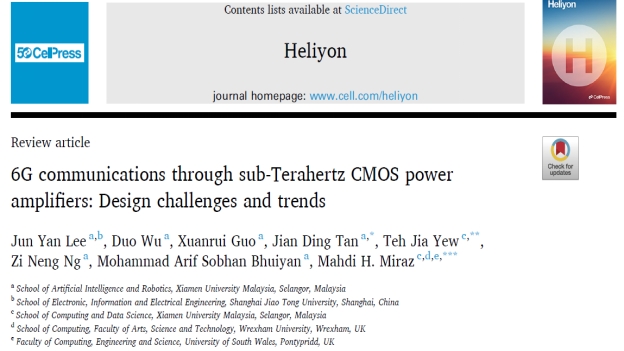Researchers from the School of Artificial Intelligence and Robotics (SAIR) and the School of Computing and Data Science (SCDS) at Xiamen University Malaysia (XMUM) have recently published a collaborative article in Heliyon, a SCIE Q1 journal indexed in the Web of Science (WoS) with an impact factor of 3.6.

The published full article can be accessed at: https://doi.org/10.1016/j.heliyon.2025.e43393
The first three authors - Lee Jun Yan (EEE1909690), Wu Duo (EEE2009240), and Guo Xuanrui (EEE1909232) - recently completed their Bachelor’s degrees in Electrical and Electronics Engineering at SAIR.
The paper, titled "6G Communications through Sub-Terahertz CMOS Power Amplifiers: Design Challenges and Trends", presents a comprehensive survey and analysis of CMOS-based power amplifier (PA) design in sub-Terahertz (sub-THz) frequency bands. The study discusses key design challenges and technological trends that are shaping the development of next-generation 6G transceivers.
Assoc. Prof. Dr. Tan Jian Ding (SAIR), Asst. Prof. Dr. Teh Jia Yew (SCDS), Assoc. Prof. Dr. Mahdi Hassan Miraz (SCDS) serve as the article’s corresponding author, while Asst. Prof. Dr. Ng Zi Neng (SAIR) and Assoc. Prof. Dr. Mohammad Arif Sobhan Bhuiyan (SAIR) contributed as co-authors.
As 6G communication technologies advance to support artificial intelligence, virtual reality, digital twins, and ultra-fast wireless connectivity, the efficiency of CMOS-based radio frequency (RF) components becomes increasingly important. Power amplifiers play a critical role in determining system performance, energy efficiency, and reliability.
The paper reviews several PA design methodologies, including coupled-line techniques, passive gain boosting, zero-degree power splitting, and linearization methods. Each is evaluated for its influence on gain, output power, and power-added efficiency - factors essential to the realization of energy-efficient and high-performance wireless systems.
By outlining circuit-level challenges and optimization strategies, the publication offers valuable insights for researchers and engineers engaged in RF integrated circuit (RFIC) design for future wireless communication infrastructures.
The study was supported by Xiamen University Malaysia through grants XMUMRF/2020-C6/IECE/0016, XMUMRF/2021-C8/IECE/0021, and XMUMRF/2021-C8/IECE/0025.






